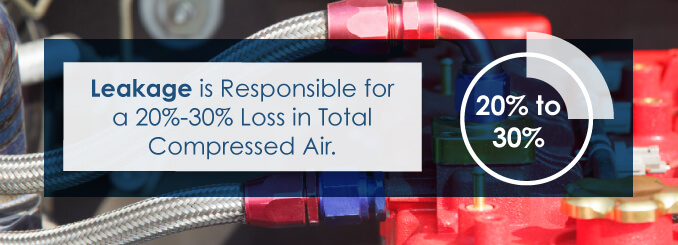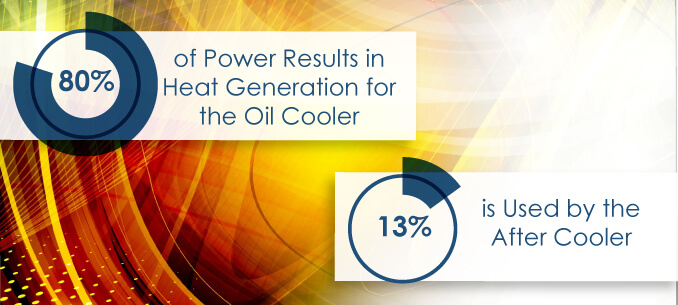
In everything from the packaging of food to the assembly of products, compressed air is relied upon for the preparation of items that are sold on the shelves of supermarkets to department stores. From the tank of the compressor to the tip of each pneumatic tool, the air must be compressed at just the right pressure and applied to its targets moisture-free. However, there are numerous internal and external factors that can hijack the process, which makes it crucial to know about the 14 R’s of compressed air efficiency.
R #1. Reduce Loss Due to Air Leakage
Compressed air efficiency is significantly compromised by leakage, which is annually responsible for a 20–30% loss in total compressed air at most plants. In cases where no maintenance is performed and the problem goes undetected, the loss can exceed 50%.
In just the span of a month, a leak of merely 1/4″ could result in a loss of three million cubic feet of air in a 100-psig system. Annually, this could result in a 107,000 kWh energy loss at power levels of 18 kW/100 cfm: a $10,700 value at 10 cents per kW. The higher the pressure, the more expensive the loss.
A leak can be attributed to one of two factors: An intentional leak, such as an open valve or condensate drain; or an unintentional leak, which can occur when hoses, valves, pipe joints or couplings get damaged or wear out over time. Leaking can also occur if idle pieces of equipment are left attached to a system when other operations are in progress.
Seasonal weather changes can also contribute to air leakage. Warmer summer months cause increased condensation levels – and leaving your condensate drains open can lead to air leakage. Too much condensation build up can cause the valves to fail, which can get messy.
On the other side of the coin, when the temperature drop dramatically, a lack of insulation can cause seals and gaskets to freeze and leak.
Leaks should be remedied upon discovery — especially anything that exceeds 10% — though it requires ongoing maintenance to keep leaks from getting out of hand.
R #2. Reduce Pressure at Low-Usage Points
When a plant has multiple tools attached during a given operation, the system is required to produce a pressure level optimal for the highest-pressure application, regardless of whether or not the application is in use. Consequently, extraneous pressure is sent through the lower-pressure applications, and the system consumes more power overall. Every 2 psig of excess pressure requires 1% more power.
In order to lower the consumption of air pressure on multiple-use systems, it’s best to specify lower pressure requirements on new equipment, and to retrofit old equipment for lower pressure. In some cases, older equipment might need to have components replaced just to operate at reduced pressure levels. Older equipment that cannot be retrofitted should be segregated to a different system. This will allow low-pressure operations to conserve air pressure and energy.
In one case study at a lumber mill, where more pneumatic power was needed for the actuation cylinders than the return stroke, the former was refitted to use 100 psi and the latter only 40 psi, which led to a 30% overall reduction in compressed air usage at the mill.
In some industries, the air compressors system is spread across hundreds of feet. Mining operations, for example, utilize underground air compressors as part of their process which often leads to the creation of expansive piping systems – and the potential for leakage or pressure loss at low usage points.
R #3. Reduce Source Pressure
You cannot really achieve compressed air energy efficiency without significant reductions in discharge pressure. For every 2-psi drop in system pressure, there’s a 1% reduction in the energy needs of a 100-psi system. On certain systems, however, savings are lost due to ill-fitted piping, which can cause low-pressure operations to use higher amounts of energy than normal.
For the sake of energy conservation, a system’s control pressure should be set to the lowest level needed for the operations in question — not the highest.
Setting the air compressor to the highest setting isn’t going to increase your efficiency. It’s going to reduce the overall lifespan of your system and could potentially lead to equipment failure in addition to energy waste.
R #4. Reduce Pressure Fluctuations With Compatible Air Receivers
In systems where the receivers are mismatched and the piping is uneven, energy is often lost due to pressure fluctuation and compressor cycling issues. An air receiver, for example, can eliminate moisture when situated in front of a dryer, but the dryer itself could get overloaded if the air compressor puts out too much air flow.
At one facility that handled mineral processing, faulty compressor controls resulted in lackluster performance. In order to accommodate its 350 hp base and twin 150 hp trim compressors, the facility upped its system storage from 400 to 4,000 gallons. Despite the improvement in compressor control, issues arose with a baghouse once the pressure was lowered. This was due to high air flow being sent through thin baghouse lines. A 60 gallon storage tank was introduced to the setup, which freed up more air through each pulse and allowed the baghouse to function at 60 psi. This, in turn, allowed pressure on the main system to be reduced.
Using storage to equalize air pressure created by non-compatible air receivers can also save you money in the long run by reducing the electrical demand during peak operating hours.
R #5. Reduce the Number of Partial-Load Compressors
With some older systems, multiple machines are used to perform operations that a newer system could handle much more efficiently.
At one aerospace manufacturing facility, three 1,500 cfm compressors were used to handle round-the-clock loads in the 350—750 cfm range. Because of high flow when the autoclave was used, 3k cfm of compressed air had to be cured for up to 15 minutes. Though the fill lasted for just a small portion of each shift, two compressors were needed because of recurrent failures whenever one was shut down. Furthermore, due to load/unload malfunctions, operators were forced to run the units in lagging modulation mode.
Ultimately, this system was swapped for a setup comprised of four rotary-screw compressors. Equipped with a master controller, the new system matched the machines to each load, resulting in an annual 2,380,000 kWh savings.
Upgrading your air compressor system to eliminate partial-load compressors might seem like an expensive choice, but it can reduce your operating costs dramatically in the long run.
R #6. Remove Low-Pressure Applications
An output of 1 hp from a pneumatic tool is the end result of 7—8 hp of compressed air. This translates to an efficiency level of around 15%, which could ultimately be even lower if leakage is taken into account.
When low pressure is utilized from a high–pressure source, the energy used by the air compressor is wasted in the process. Therefore, the use of compressed air for unnecessary applications is an expensive practice. As such, when a tool only needs as much as 22 psi from an air compressor, it’s actually more efficient to use a blower. For example, when an electrical cabinet needs to be brought down in temperature, it’s more efficient to use a fan. Other alternatives to high-pressure compression tools include blow guns and vacuum pumps.
Compressed air for temperate control isn’t the only potential loss point when it comes to low pressure applications. Some tools, such as a brad nailer, only requires 0.3 cfm (cubic feet per minute) at a system that runs between 70 and 90 PSI. If the rest of your tools require much more pressure, removing this tool from the system and using an electrical or battery powered alternative could help equalize the pressure throughout the compressed air network.
R #7. Reduce Pressure Drop
Extreme differences in pressure between two points in a distribution network can occur when hoses are ill-fitted to the connections on an air compressor. Ideally, this difference — the pressure drop — should never surpass 10% of the discharge pressure that passes from an air compressor to any connected tools. Pressure drop percentages can be decreased with the use of gate valves and loop-shaped passages.
Pressure drop often occurs with older air compressors — many times, the ones that aren’t really suited for their current usage, but have nonetheless been adapted to an expanding array of tools. Consequently, these compressors are often ill-equipped to meet present-day demands. Particularly problematic is when pipe lengths and flow rates are inadequate because the system’s piping has been determined by the size of the compressor’s discharge connection. The maximum air velocity used throughout a piping system should never surpass 50 ft/s (fps).
Keep an eye on the ambient temperature as well. If your compressor gets too warm, it will not be able to produce air as efficiently. While you might not be able to store a large compressor within your building, keeping it shaded and at a comfortable temperature can help improve your system’s efficiency and prevent pressure drop.
R #8. Remove Moisture According to Application Needs
Dew point requirements vary from one application to another. Air drying, however, should not exceed the level needed for a given application. In some systems, a dryer is placed next-in-line to the compressor for the purpose of drying everything to the same level, regardless of the usage to which the air is being applied. This can be a costly use of energy.
The exterior humidity might also affect your systems drying point, especially in states where the exterior humidity level is frequently above 50 percent. Keeping an eye on your local daily weather report can help you to adjust the drying point pressure accordingly.
For a lot of basic applications, a general drying dew point pressure of 38° F is sufficient. However, the pipes and drains through which air is passed must be taken into account, especially if there are any freezing temperatures along the way. You can conserve energy by reviewing each application to assess the drying needs, and adjust the dryer accordingly when a given application is underway.
R #9. Remove Condensate While Conserving Air
Condensate is drained in numerous ways from the machines that form an air compressor system. Depending on the climate and environmental factors of a given work-site location, the needs of a system can vary. When it comes to drain-trap size, selections should be made based on the expected condensate rate for the location in question, as well as the expected contamination rate of applicable lubricants.
Without proper maintenance, drains and traps gradually clog inside. This causes excess moisture to accumulate in the system and gradually forms into water, which can have the following effects:
- Corrosion in the pipes and air receiver
- Malfunctioning of valves
- Erosion of lubricants along cylinders and valves
- Exhaustion of filters and dryers
A faulty practice that’s often employed involves leaving the drain valve slightly open, which only causes compressed air to escape. Regardless of the drain trap, the best way to ensure maintenance is in the form of bypass piping.
If condensate contamination is an issue, consider installing a condensate purifier that can remove any and all contaminants from the system. The filter can also be easily removed and replaced, allowing you to safely dispose of any oils or lubricants that might end up in your condensate system. This will eliminate the need to leave a condensate trap open, which can lead to air loss.
R #10. Reduce Downtime With Preventive Maintenance
Potential problems with an air compressor should be traced in advance and remedied before they lead to costly repairs and downtime. Even though a lubricant might be guaranteed to last for x number of hours, the filters and separators on which the lubricant is applied might fail sooner if unmonitored drops in pressure take their toll.
Downtime is expensive – 98 percent of businesses surveyed state that just one hour of downtime costs more than $100,000, and 33 percent of businesses stand to lose between $1 and $5 million in the same amount of time. The amount of money that downtime will cost you will depend on your industry, your profit margin and, and how quickly you can repair your air compressors.
Downtime can be reduced dramatically by simply performing preventative maintenance on your compressors and related equipment.
When a microprocessor shows signs of needed maintenance, the issue should be dealt with immediately. Condensate drains should also be inspected routinely for signs of distress. Keep files on hand of all tune-ups and parts replacements. The intervals between such maintenance can be used to determine the needed frequency for repairs and checkups.
In one case that has come to exemplify the troubles with maintenance oversight, a foundry had to rent a trio of diesel powered compressors to compensate for its own lagging system. The problem stemmed from poor upkeep of their own four-compressor system at the rail-wheel-making plant. Not only did this cause the system to lag, but it also made the air too hot and caused the coolers to trip.
It turned out that the in-house air compressors were leaking 1,100 cfm each weekend. Furthermore, one machine wouldn’t open at the inlet while another was failing to load. After the system underwent a series of much-needed repairs, the plant saved $90,000 annually with a system reduced to just three compressors.
R #11. Record Data on Maintenance and Repairs
Records should be kept of all maintenance procedures for the purposes of analysis and priority setting. By tracking the frequency of when maintenance or repairs are needed on a particular part of an air compressor, it’s easier to set a schedule going forward of when to perform inspections. This way, it’s also easier to forecast a maintenance budget, because you’ll know the frequency at which certain parts will be due for repair or replacement.
With maintenance records on hand, you can also identify which areas more frequently need attention and the types of measures that are generally required to rectify a given problem. Notes should also be taken of how a particular component behaves, both before and after maintenance. This can help you to troubleshoot and determine whether an issue is isolated or systemic.
Keeping track of your maintenance and repairs can also provide you with a paper trail, which is vital if you bring in third party repair technicians. If a system that has been repaired fails again almost immediately, you have a record of the work that was done so you can call them back out to fix what wasn’t correctly repaired the first time.
R #12. Regularly Track Changes in Air Usage
In order to track changes in air usage, it helps to observe pressure levels along specific points in the system. One thing that this won’t make clear, however, is the rate at which these changing patterns occur. For that, it’s wise to keep a data log.
As years go by, a plant will typically introduce new air compressors and phase out old ones. At the operating end, attention must be given to pressure fluctuations that might occur when a new component operates at a different usage level than an adjoining older piece of machinery. In such cases, additional upgrades might be necessary, and it’s better to find these things out sooner rather than later.
Keeping track of your air usage can also help you recognize where problems are starting to occur – if one particular area is suddenly using more air than it has in the past, it could indicate a leak or another problem that needs to be addressed quickly.
R #13. Recover Heat
In most air-cooled rotary compressors, 80% of the power results in heat generation for the oil cooler, while 13% of the remaining power is used by the air aftercooler. A substantial amount of heat can be recovered from these operations and can be redirected for other purposes.
For example, at one small-town bottle reconditioning plant, 15kW of heat is generated by a 25-hp air compressor. With the bottles hung from a conveyer for reconditioning, most of the heat is used for drying purposes, while the remaining heat is used to clear out air in the facility. This all results in roughly $2,500 of annual energy savings.
Depending on your set up, trapped heat could even be fed into a hot water system and used to heat your building or even to heat the water that comes from your taps, saving you money in the long run and creating the most efficient air compressor design. Recovering the heat generated by your compressor can also reduce the greenhouse gasses generated by the facility.
R #14. Reduce the Cost of Energy / Boost ROI
As part of an industry-wide collaborative effort known as The Compressed Air Challenge, plants that use air compressors are employing all types of preventative maintenance and energy conservation techniques to slash operating costs, minimize repairs and downtime, and improve the quality of finished goods.
At many plants with multi-compressor systems, operational improvements have allowed for the shutdown of at least one machine, which has led to huge savings in energy and maintenance. Companies are able to make more money from their products because there’s reduced overhead involved. With much-improved machine performance and defect-free operations, product quality has substantially improved in many participating industries.
Investing in a new and more efficient compressor system might seem expensive but it can generate a much better return-on-investment than simply repairing an old system over and over again.
Energy Efficiency With Quincy Air Compressors
Quincy Compressor has been a leading supplier of air compressors and related tools for almost a century. With happy customers in the fields of automation, construction, general manufacturing, food processing, product assembly and a whole lot more, the machines from our inventory have been responsible for edibles and luxuries that people consume everywhere.
With Quincy compressed air equipment and service solutions, products can be painted, cleaned, assembled and readied with utmost ease in a wide range of environments. Visit the Quincy website today to learn of more ways that compressed air efficiency can make your productions a whole lot less expensive and easier.






